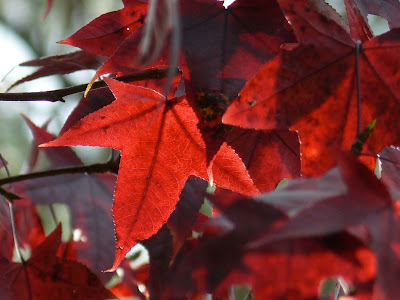 Well, maybe not quite, but it felt that way a little this morning, as we got to the top of a mountain. The world below us was covered in clouds, it was probably a dull and dreary January day down there, but where we were, it was sunny and beautiful.
Well, maybe not quite, but it felt that way a little this morning, as we got to the top of a mountain. The world below us was covered in clouds, it was probably a dull and dreary January day down there, but where we were, it was sunny and beautiful. The elevation here is actually a little lower than around San Cristóbal, and it’s decidedly less cold around here, although the hour before sunrise can still be a bit cool. A little after 6 AM, local forestry official Pedro drove us 12 km out of town, to an area that had cloud forest on one side of the road, and – as we later discovered – very small tracts of remaining forest amid larger logged areas on the other. Unfortunately, this was not visible from the road, or we probably wouldn’t have gone there. I figured it was best to climb the mountain ahead of us – it would give us great views of the area, and once up there we would be able to judge which place held the most promise of encountering Golden-cheeked Warblers.
The elevation here is actually a little lower than around San Cristóbal, and it’s decidedly less cold around here, although the hour before sunrise can still be a bit cool. A little after 6 AM, local forestry official Pedro drove us 12 km out of town, to an area that had cloud forest on one side of the road, and – as we later discovered – very small tracts of remaining forest amid larger logged areas on the other. Unfortunately, this was not visible from the road, or we probably wouldn’t have gone there. I figured it was best to climb the mountain ahead of us – it would give us great views of the area, and once up there we would be able to judge which place held the most promise of encountering Golden-cheeked Warblers.Once we got up there, all we saw were tiny plots with huge pines and slightly bigger plots with mostly sweet gum.
 This is the red-leaved variety of sweet gum…
This is the red-leaved variety of sweet gum… … and this is the yellow-leaved variety. This tree is usually associated with running or standing water nearby.
… and this is the yellow-leaved variety. This tree is usually associated with running or standing water nearby.We hiked this mountainside for hours but encountered very few birds. Hummingbirds were the only ones really abundant here. Nasty creatures they are; I saw one dive-bombing a female Flame-colored Tanager. Eventually the tanager took cover among shrubs on the ground, where the hummingbird continued to harass it until it finally gave up. Yesterday we saw the same thing happening to a Townsend’s Warbler.
When we got to a patch of cloud forest, we decided to hike upslope in hopes of encountering warblers there, but all we found – besides the ubiquitous Wilson’s Warblers – was an Azure-hooded Jay, and a Resplendent Quetzal calling. We tried to look for the quetzal but never saw it. Later we heard a Collared Trogon, and as usual quite a few Mountain Trogons.
Three species of trogon is pretty cool when you’re out fun birding of course, but we were looking for mixed flocks and Golden-cheeked Warblers and weren’t finding them. Around 10:30 AM, we decided we’d better hike back to the road. I kept my ears open for any type of warbler chip, thinking a late-encountered flock would still be a good starting point for the next day.
Fairly close to the road, I heard a chip that to my ears was either a goldencheek or a black-throated green. Among the virens super-species, a Townsend’s Warbler chip is louder (and among them, males again louder than females), while a Hermit Warbler chip is softer. And sure enough, it was a male Black-throated Green Warbler. Thinking this was a good place to rest – after all, we had been hiking steep terrain almost continuously for over four hours – we sat down, and waited for other flock members to appear. There – another chip, sounds similar. Yes, another BT green, also a male. We observed these birds for a while, as they calmly and methodically foraged in sweet gum trees.
Then, as we got to the road, I heard another chip, and this time it was an adult male Golden-cheeked Warbler.
 Here it is, feeding in a favorite tree species, Quercus sapotifolia, a type of encino oak. The bird is less heavily marked than most other males we’ve seen here, but, as I said to field assistant Hector, “it may not have much black, but everything that should be black on an adult male, is black”. Meaning, the throat was entirely black, including the chin, and also the upperparts were black. Most adult males have more black on the breast and sides, though. And the undertail coverts – to come back to an earlier posting – were clean white on this bird.
Here it is, feeding in a favorite tree species, Quercus sapotifolia, a type of encino oak. The bird is less heavily marked than most other males we’ve seen here, but, as I said to field assistant Hector, “it may not have much black, but everything that should be black on an adult male, is black”. Meaning, the throat was entirely black, including the chin, and also the upperparts were black. Most adult males have more black on the breast and sides, though. And the undertail coverts – to come back to an earlier posting – were clean white on this bird.After this sighting, we walked the full 12 km back to town.
No comments:
Post a Comment